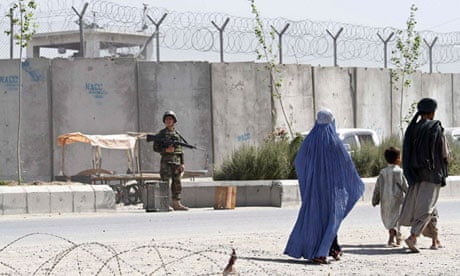The use of torture has risen in Afghan police jails over the past year, and there are "credible reports" the country's intelligence service has created secret prisons and sometimes hides detainees from international observers, a damning UN survey has found.
Just over half of prisoners held in connection with Afghanistan's long-running war endured torture or ill-treatment while in custody between October 2011 and October 2012, with 14 different methods recorded, including electric shocks, twisting of genitals, beatings with cables and rifle butts and suspension from the wrists or feet.
In southern Kandahar city, which appears to have the most extensive and deep-rooted problems with torture, dozens of men have also "disappeared" while in police custody, according to the 123-page report by the UN's human rights office in Afghanistan, which includes a detailed, 20-page response from the Afghan government.
Torture is unlikely to diminish unless ministers and top security commanders are willing to prosecute and fire officials connected with mistreatment, and stop using confessions obtained through torture in court cases, the top UN human rights official in Afghanistan warned.
"Torture cannot be addressed by training, inspections and directives alone, but requires sound accountability measures to stop and prevent its use," said Georgette Gagnon. "Without deterrents … Afghan officials have no incentive to stop torture."
The report is worrying reading for foreign governments supporting Afghanistan's police and army, both with troops on the ground and financially. There are legal restrictions on handing over prisoners if they will face a substantial risk of torture, and even though transfers have been restricted, voters may be unhappy about funding security forces implicated in torture.
The Afghan government admitted there might be occasional lapses in a system it was still strengthening, but denied "severe cases of inhuman treatment", dismissed the findings of systematic torture as "exaggerated", and said insurgents were trained to allege torture if captured. The National Directorate of Security (NDS) also denied hiding prisoners or running secret jails.
The UN, which surveyed 635 prisoners, said it used high standards of proof and had dismissed 51 claims that were not credible. The survey also found the nature of abuse reported differed from jail to jail, but within individual detention centres was often consistent across months and prisoners from different insurgent groups.
"It is improbable that training would be so well tailored to specific facilities … and the pattern of allegations of ill-treatment did not correspond with any identifiable ideological agenda," it said.
The UN team, which visited 89 detention centres and was denied access to just one intelligence service jail, found "multiple credible and reliable incidents of torture and ill-treatment had occurred particularly in 34 facilities".
The torture was systematic in seven police jails and two intelligence detention centres, all but one of them in Kandahar, birthplace of the Taliban and long a stronghold of the insurgency. Torture by police and intelligence officials "was most prevalent" in Kandahar, the UN said.
It is also the only place where "disappearances" in police custody were reported.
Ten other intelligence service prisons and 15 other police jails across Afghanistan had multiple reports of torture, but the only other place where systematic use of torture was reported was the intelligence service's counter-terrorism centre in Kabul.
The Nato-led coalition fighting in Afghanistan, which handed over 25 prisoners who were later tortured by Afghan authorities during the year covered by the report, has already stopped transfers to several Afghan prisons and promised stricter controls on the fate of detainees. Checks and a short-term halt to transfers after a previous report was released in October 2011 helped reduce torture in intelligence service jails, but the impact of measures by the International Security Assistance Force (Isaf) appears to have been temporary.
"The use of torture … resumed in most of the facilities after Isaf had certified them, restarted transfers and reduced its monitoring," the report said. Just over a third of detainees experienced torture in security service prisons, down 12% from the previous year. But there are concerns that because of the scrutiny of conflict-related prisoners, the NDS may have tried to hide prisoners or channelled them into police custody, where torture was up 8%.
Of the prisoners interviewed, 105 were children under international law, and a large majority of these juvenile prisoners had been tortured. Only a very small portion of prisoners had been in Afghan army or Afghan local police custody, but they also reported torture by those forces. Despite the training and inspections, no one has been fired or prosecuted for torture by the police or intelligence services since the first UN report on torture in jails was published in October 2011, and the UN described a culture where torture is often considered a useful, legitimate tool.
"A majority of NDS and ANP [Afghan National Police] officials do not accept that torture is ineffective and counter-productive as a tool to obtain strategically valuable and actionable intelligence to fight terrorism and conflict-related activities, let alone a serious crime under Afghan and international law," the report said.
Arbitrary detentions that run long past the 72 hours allowed for preliminary investigations under Afghan law, often without any access to family or lawyers, mean physical signs of ill-treatment have often faded by the time detainees reach court. And confessions, often used as the main basis to prove a case in Afghan courts, are rarely examined or challenged by judges or prosecutors as forced, the report said.
